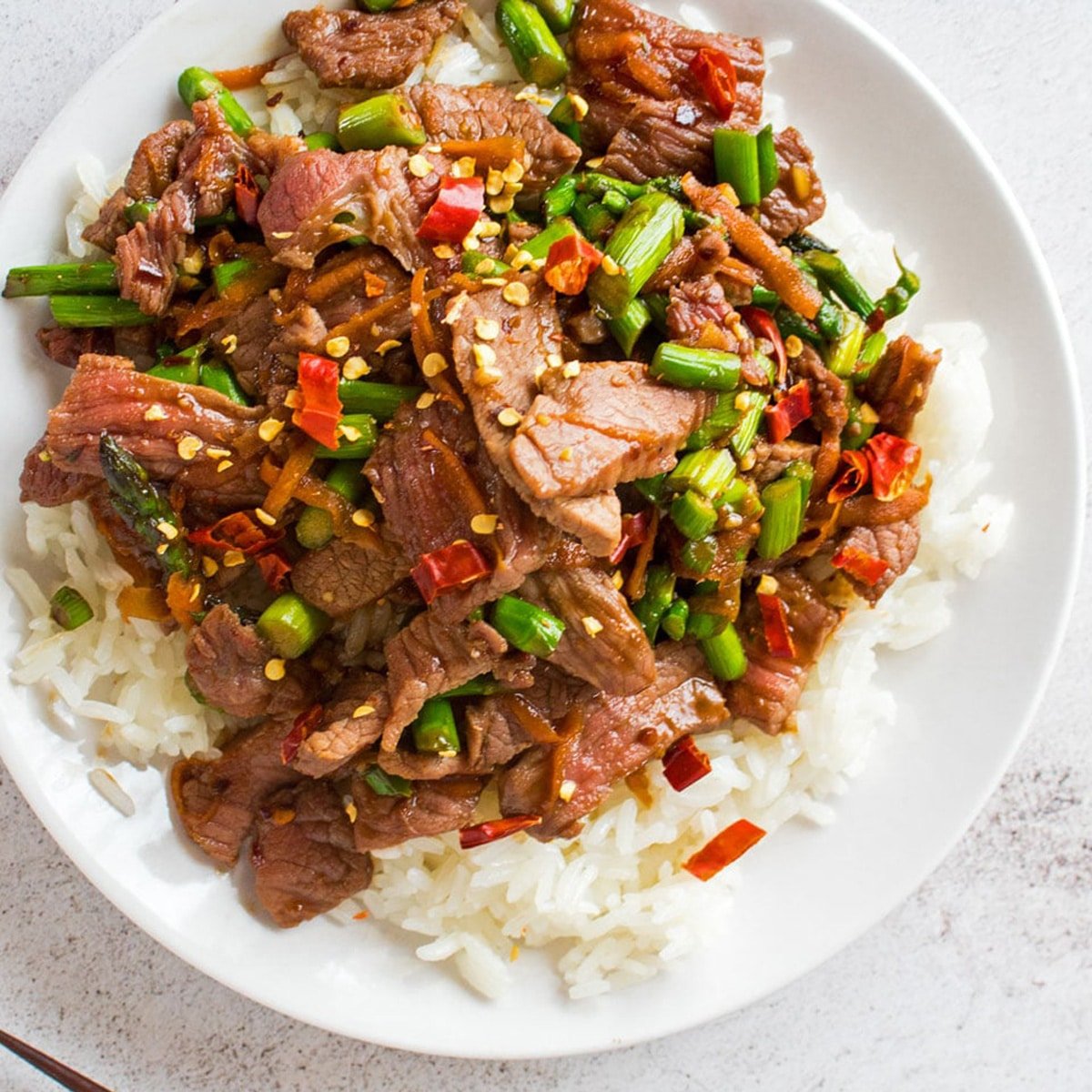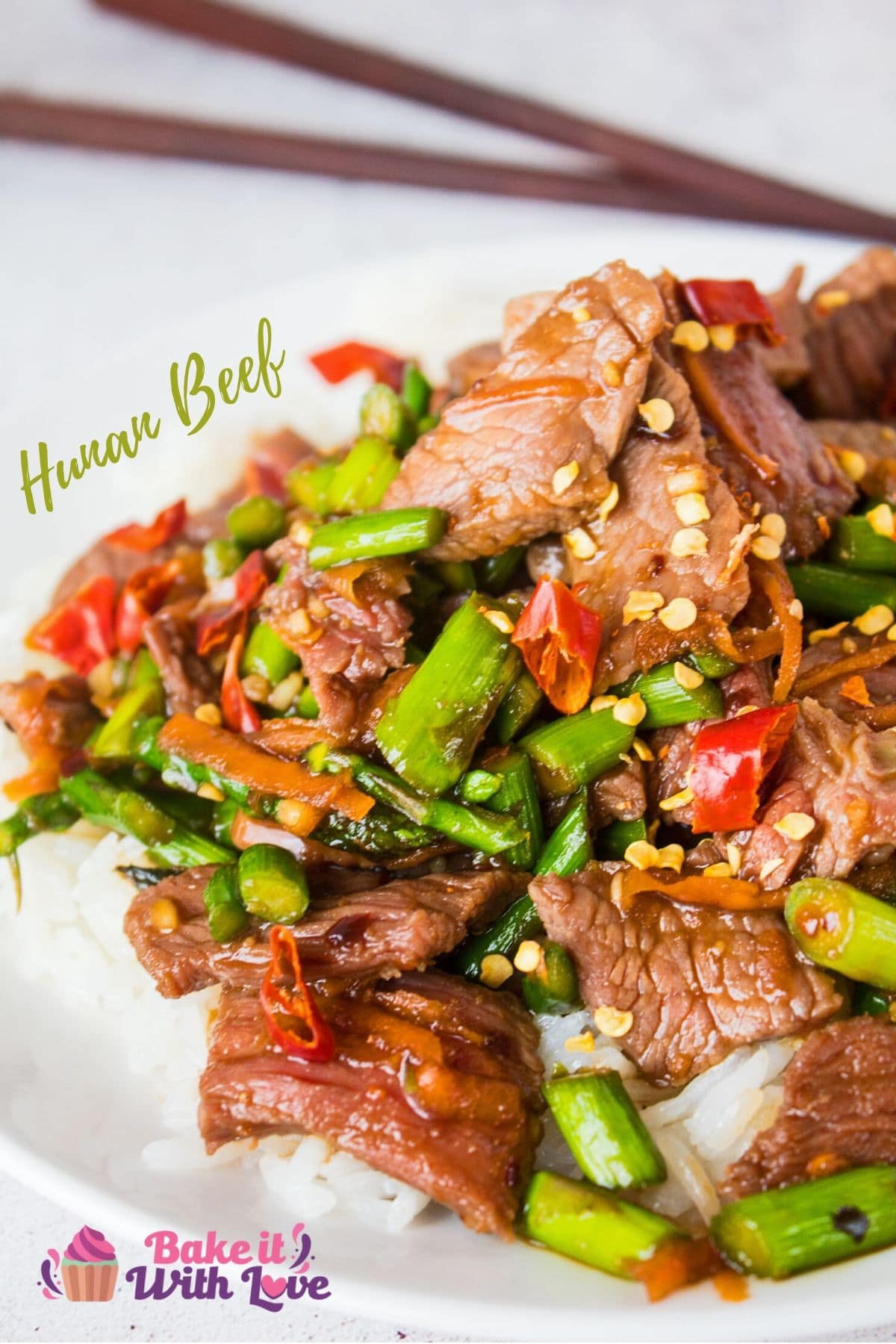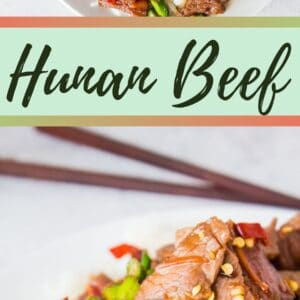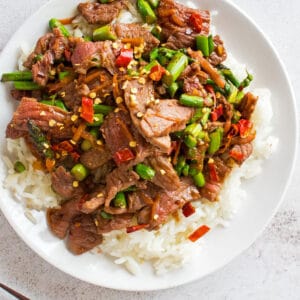Hunan beef is a popular, savory, and spicy Chinese take-out dish. Made with thinly sliced steak stir-fried in a garlic and pepper sauce with colorful vegetables. The Hunan province is known to have a wide variety of produce, so an assortment of your favorite vegetables can be used!
Serve it with Instant Pot jasmine rice or basmati rice, or pair it with chow mein.

Jump to:
My easy Hunan beef dinner has spicy chili flavors, tender, savory marinated beef, and fresh vegetables!
I usually like to add celery and green onions, but I felt the need for asparagus and carrots today. Add what you like and what your family will enjoy!!
It's one of those Chinese-American dishes I remember enjoying as a kid, so it's one of my recipes that I have always loved cooking up for a special 'chill at home' kind of night.
❔ What Is Hunan Beef
Hunan Beef is a hot, spicy, stir-fried beef dish with dried chilies and garlic. Hunan cuisine (also known as Xiang cuisine) is known for its hot and spicy flavors and its fresh aroma.
Additionally, Hunan cuisine is known for being bright and colorful. The province produces a large agricultural crop, so the fresh ingredients change seasonally. Since there are three regions within the Hunan province, this beef dish has many variations that could still be completely 'authentic' or 'traditional'!
This dish uses fresh or dried peppers, if desired, as well as pickled yellow peppers. The beef from an authentic Hunan Beef dish would be smoked beef that is hard to get or even find, so the beef used in this recipe is marinated to add flavor.
🤔 What's The Difference Between Hunan Beef And Szechuan Beef
While both Hunan and Szechuan beef are known for their spicy, smoky flavor, they are from two different provinces in China that have completely separate cooking styles (two of the eight cuisines of China).
One of the easiest ways to describe the difference is the ingredients used to add 'heat' to each style. Hunan-style beef is a dry, hot dish with the heat from fresh, dried, pickled peppers, or 'gan la, a dry, spicy dish.
The Szechuan beef is cooked with a spicy and numbing heat or 'ma la' from Sichuan peppercorns and dried chilies. This numbing sensation can be described as 'tingly' or mouth-numbing and is paired with a slightly sweet flavor in Szechuan cooking.
Generally speaking, Szechuan beef is cooked with more oil and dried or preserved ingredients than Hunan-style beef.
Despite this 'tingly' or numbing sensation of Szechuan cooking, you will find that Hunan Beef is still the spicier of the two cuisines.
🥘 Ingredients
After a quick run to the grocery store, you'll be ready to go! I like to use Thai Chile peppers, but feel free to use your favorite variety (and adjust the spice level!)
Marinade for the Beef
- Water - 2 tablespoons of water.
- Cornstarch - ½ teaspoons of cornstarch.
- Oyster Sauce - 2 teaspoons of oyster sauce.
Hunan Beef
- Flank Steak - 1 pound flank steak. This is the most commonly used beef cut, but you can use other lean beef cuts. I have always had great success when using sirloin as well. Strip steak or ribeye steak can be used with tasty results. Trim the fat as needed.
- Cornstarch - ⅓ cup of cornstarch.
- Vegetable Oil - ⅓ cup of vegetable oil.
- Carrot - 1 large carrot that has been washed and grated.
- Asparagus - 1 pound of asparagus, cut.
- Thai Chile Peppers - 8 Thai Chile peppers. You can have these either whole, sliced, or crushed.
Garlic Sauce
- Garlic - 2 tablespoons of finely minced garlic.
- Fresh Ginger - 1 tablespoon of grated fresh ginger.
- Black Pepper - ½ tablespoon of freshly ground pepper. You'll want to use freshly ground for the best flavor. (If you do use preground pepper, drastically reduce the amount to about ¼ teaspoon).
- Shaoxing Wine - ¼ cup of Shaoxing wine. If you don't have any, you can use rice wine (but it will cause the flavor to be lighter).
- Soy Sauce - 2 tablespoons of soy sauce.
🌶️ Pick Your Peppers
There's a wide variety of peppers that will work for your Hunan-style beef stir fry! I'm using one of my on-hand pantry items, as I always keep my Thai red chile peppers available!
You can add the Thai chile peppers whole, and the flavor will be nice but not too spicy. Slice or crush the peppers, including the seeds, for a wonderful spicy dish!!
Fresh peppers such as sweet bell peppers or mild poblano, hatch, or Holland peppers can be sliced or chunked and added to your stir-fry. Or increase the heat and add jalapeno, serrano, Fresno...or scotch bonnet, or (gulp) ghost peppers. I'll pass on that last one!
*Be sure to see the free printable recipe card below for ingredients, exact amounts & instructions with tips!*
🔪 How To Make Hunan Beef
There's nothing tricky about this recipe; make sure to keep an eye on your beef so it doesn't burn in the hot oil! Grab a sharp knife, some mixing bowls, and your wok pan.
This meal makes a great weeknight dinner as it makes 4 servings and is easy to whip up!
Prepare the Marinade
- Prepare your beef. Cut 1 pound of flank steak into thin strips.
- Make the marinade. Mix the marinade (2 tablespoons of water, ½ teaspoon of cornstarch, and 2 teaspoons of oyster sauce) in a medium bowl and gently work into the meat until all of the marinade has been absorbed.
- Marinate. Refrigerate and allow the meat to marinate for at least 30 minutes (or overnight).
- Coat. Lightly dredge all of the marinated beef in ⅓ cup of cornstarch and set aside.
Make The Garlic Sauce
- Get the ingredients. Gather your garlic sauce ingredients: 2 tablespoons of minced garlic, 1 tablespoon of grated ginger, ½ tablespoon of fresh coarse ground black pepper, ¼ cup of Shaoxing wine, and 2 tablespoons of soy sauce. Do not use already ground black pepper (or use a drastically reduced amount like a ¼ teaspoon).
- Mix. Combine the sauce ingredients and set aside until after the meat has been fried.
Stir Fry
- Heat the oil. Bring a wok to high heat with ⅓ cup of vegetable oil, until the wok is smoking. *You will need to cook the thinly sliced beef in small batches.
- Brown the beef. Carefully place sliced beef in heated oil and cook until browned and starting to get slightly crispy. It won't take long, so don't turn your back on it!
- Finish cooking the meat. When the beef is ready to transfer out of the wok, pull it up the side of the wok and allow the cooking oil to drain back into the well of the wok. Then, transfer to a plate or a sheet pan. Repeat until all of the thin-sliced steak pieces are cooked.
- Reduce heat. Clean any debris out of your oil, but leave about 2 tablespoons worth of oil in your wok to continue cooking. Bring the remaining oil to medium heat.
- Cook the peppers. Add the 8 Thai chile peppers to the heated oil, and cook for about 30 seconds.
- Add asparagus. Then, add 1 pound of sliced asparagus and fry it for about one minute.
- Mix in the sauce. Stir in the Hunan beef garlic sauce, stir-frying with the asparagus for about one minute.
- Increase heat. Return the cooked beef slices to the wok, add in the 1 grated carrot, and increase the heat to high.
- Stir fry. Continue to stir fry for 1 - 2 minutes or until the asparagus has reached your desired level of tenderness. Most of the sauce should have thickened and cooked off.
- Serve. Remove from heat and serve over steamed rice.
Serve your Hunan beef with other Chinese take-out dishes. Your entire family will love it! Enjoy!
💭 Angela's Pro Tips & Recipe Notes
- Cutting the Beef: When preparing your beef, always slice it against the grain. This technique ensures that the cooked beef is tender and easy to eat, regardless of the cut you choose.
- Shaoxing Wine Substitute: If Shaoxing wine isn't available, rice wine can be used as a substitute. However, keep in mind that rice wine imparts a lighter flavor compared to the deep, rich taste of Shaoxing wine, which complements the bold flavor profile of Hunan beef.
- Marinating Time: For the best flavor, marinate the beef for at least 30 minutes. If time allows, an overnight marination in the fridge can further enhance the taste and tenderness of the meat.
🥡 Storing & Reheating
Cool any leftovers, then transfer them into an airtight container. Store in the refrigerator for up to 5 days.
You can reheat your leftovers either in the microwave or by warming them on the stove in a skillet. Heat over medium-high heat until warmed.
>>>>See all of my recipes here<<<<
❓ Recipe FAQs
For this recipe, I used asparagus and carrots, but you can easily mix in your favorite veggies! Try out some broccoli, baby corn, mushrooms, zucchini, sugar snap peas, or bok choy!
This classic Chinese dish is sweet, spicy, and tangy with a nicely balanced umami flavor (due to the oyster sauce and soy sauce). It is well-rounded and has nice layers of different flavors!
This tasty dish comes from the Hunan province of China. This region is known for its veggies as well as its sour and spicy sauces.

🥡 Tasty Homemade Take-out Dishes
- Panda Express Teriyaki Chicken - In just 15 minutes, you'll be ready to enjoy this chicken and homemade teriyaki sauce dish!
- Honey Walnut Shrimp - Tempura battered shrimp is wok-fried and tossed in a honey sauce!
- Sweetfire Chicken Breast - The Thai sweet chile sauce brings just the right amount of heat to this chicken dish!
- Shanghai Angus Steak - A tasty stir-fry featuring steak, mushrooms, asparagus, and onions!
- General Tso's Shrimp - The homemade General Tso's sauce is better than anything you'll get from a restaurant!
- Sweet & Sour Chicken - A classic, popular takeout dish- this sweet and sour chicken is sure to be a family favorite!
Do you love a recipe you tried? Please leave a 5-star 🌟rating in the recipe card below and/or a review in the comments section further down the page.
Stay in touch with me through social media @ Pinterest, Facebook, Instagram, or Twitter! Subscribe to the newsletter today (no spam, I promise)! Don't forget to tag me when you try one of my recipes!
📖 Recipe Card
Hunan Beef
Ingredients
Marinade for the Beef
- 2 tablespoon water
- ½ teaspoon cornstarch
- 2 teaspoon oyster sauce
Hunan Beef
- 1 lb flank steak
- ⅓ cup cornstarch
- ⅓ cup vegetable oil
- 1 large carrot (washed and grated)
- 1 lb asparagus (cut)
- 8 Thai chile peppers (whole, sliced, or crushed)
Garlic Sauce
- 2 tablespoon garlic (finely minced)
- 1 tablespoon fresh ginger (grated)
- ½ tablespoon fresh ground black pepper (do not use already ground black pepper)
- ¼ cup Shaoxing wine
- 2 tablespoon soy sauce
(Note: 2x or 3x only changes the ingredient list)
Instructions
- Combine 2 tablespoon water, ½ teaspoon cornstarch, and 2 teaspoon oyster sauce in a medium bowl. Add the cut 1 lb flank steak into strips and gently work the marinade into the beef—marinade in the refrigerator for at least 30 minutes.
- Dredge your marinated beef in the second portion of ⅓ cup cornstarch. Set lightly coated beef aside.
- Combine the 2 tablespoon garlic, 1 tablespoon fresh ginger, ½ tablespoon fresh ground black pepper, 2 tablespoon soy sauce, and ¼ cup Shaoxing wine. Set aside.
- Add the ⅓ cup vegetable oil to your wok and bring to high heat, until smoking. Sear the beef in small batches. Cook until browned and beginning to get crispy, then push up out of the well of the wok onto the sides to drain excess oil. Transfer to a plate or sheet pan and repeat until all of the beef is cooked.
- After the beef has been cooked, remove any residue from the remaining oil. Reserve about 2 tablespoons worth of cooking oil in the wok for stir-frying the rest of the ingredients.
- Heat the wok and oil over medium heat. Add the dried 8 Thai chile peppers and cook for about 30 seconds. Add the sliced 1 lb asparagus and fry for about one minute.
- Add the garlic sauce, stir, and fry for about 1 minute. Return cooked beef and add the grated 1 large carrot to the wok and cook over high heat for 1-2 minutes, or until asparagus is your desired level of tenderness and most of the sauce has cooked off.
Notes
- Whatever beef you choose, cut against the grain to yield tender cooked portions of beef.
- If you don't have Shaoxing wine, you can use rice wine but the flavor will end up being a bit lighter. The Shaoxing wine has a deep, rich flavor that will add to the salty, bold flavor of the Hunan beef.
- Allow your meat to have at least 30 minutes to marinate. However, you can leave it in the fridge overnight as well!



Marc A says
Fabulous and super tasty, this one is a keeper for sure!
Mikey says
This baby will ward the vampires off for sure. I cooked it one night at short notice, which turned out a treat. I did accidentally add the cornstarch to the garlic sauce instead of the beef. Even then, it was not too much of a botch. Hopefully, I will cook this sucker many more times; Chinese cooking has become more of a chapter in my cooking repertoire over the past couple of years.